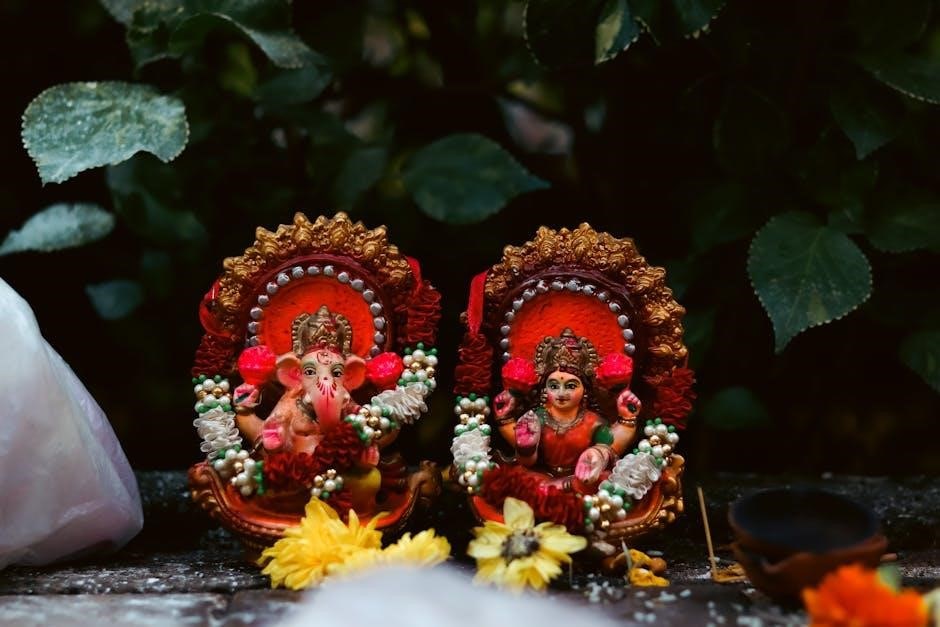sri lakshmi ashtottara shatanama stotram telugu pdf
The Sri Lakshmi Ashtottara Shatanama Stotram is a revered devotional hymn dedicated to Goddess Lakshmi, embodying 108 sacred names that extol her divine virtues and grace. This sacred text, deeply rooted in Hindu spirituality, is often recited for prosperity, peace, and spiritual growth. Its elegant composition and profound meanings make it a cherished part of daily worship rituals, offering devotees a profound connection to the Goddess of Wealth and Wisdom.
Significance and Importance of the Stotram
The Sri Lakshmi Ashtottara Shatanama Stotram holds immense spiritual and cultural significance, being a powerful hymn that glorifies Goddess Lakshmi, the embodiment of wealth, prosperity, and divine grace. Reciting this stotram is believed to bring blessings, material abundance, and inner peace, making it a cornerstone of Hindu devotional practices. Its 108 names encapsulate the multifaceted nature of the Goddess, reflecting her compassion, wisdom, and nurturing qualities. Devotees often chant it during auspicious occasions and daily prayers to seek her benevolence and guidance. The stotram’s profound verses are not only a means of worship but also a pathway to spiritual enlightenment and emotional solace, resonating deeply with those seeking harmony and balance in life.
Overview of the Structure and Composition
The Sri Lakshmi Ashtottara Shatanama Stotram is a devotional hymn structured as a poetic composition, comprising 108 sacred names of Goddess Lakshmi. Each name is a verse glorifying her divine attributes, such as prosperity, wisdom, and compassion. The stotram is written in the Telugu language, using a simple yet elegant script that preserves its spiritual essence. The composition follows a rhythmic pattern, making it easy to recite and memorize. The hymn begins with an invocation of the goddess, followed by a series of names that eulogize her universal benevolence. The structure is designed to evoke devotion and contemplation, allowing devotees to connect deeply with Goddess Lakshmi. The Telugu PDF version maintains the traditional format, ensuring accessibility for those familiar with the script, while also catering to modern readers seeking digital convenience.

Understanding the Ashtottara Shatanama Stotram
The Sri Lakshmi Ashtottara Shatanama Stotram is a sacred Telugu hymn comprising 108 divine names of Goddess Lakshmi, each highlighting her virtues and blessings. Recited for prosperity and peace, it is a powerful devotion to invoke her grace and harmony in life.
The 108 Names of Goddess Lakshmi
The Sri Lakshmi Ashtottara Shatanama Stotram comprises 108 divine names of Goddess Lakshmi, each encapsulating her celestial virtues and attributes. These names, rich in spiritual significance, are recited to invoke her blessings for prosperity, wisdom, and inner peace. The stotram begins with an invocation of the goddess, followed by a lyrical enumeration of her names, each highlighting her role as the embodiment of wealth, knowledge, and divine grace. The names are structured in poetic couplets, making them easy to memorize and chant. In the Telugu version, the names are rendered in the Telugu script, preserving the traditional recitation style. Devotees believe that reciting these 108 names with devotion attracts positive energy and fulfills heartfelt desires. The stotram is widely available in PDF format, enabling easy access for those seeking to incorporate it into their daily worship rituals.
- The names are a blend of Sanskrit and Telugu, reflecting cultural synthesis.
- Each name symbolizes a unique aspect of Goddess Lakshmi’s divine personality.
- The stotram is often chanted during pujas and auspicious occasions.
- The Telugu PDF version ensures accessibility for Telugu-speaking devotees.

Language and Script in the Telugu Version
The Telugu version of the Sri Lakshmi Ashtottara Shatanama Stotram is widely revered for its linguistic beauty and spiritual significance. The stotram is composed in simple yet profound Telugu script, making it accessible to devotees who prefer worshiping in their native language. The text incorporates traditional Sanskrit-based Telugu, with anusvaras and other Vedic accents, ensuring the chants retain their sacred essence. Some versions are simplified to accommodate devotees less familiar with classical Sanskrit, while others preserve the intricate script for purists. The Telugu PDFs available online often include both simplified and classical versions, catering to diverse preferences. This linguistic adaptability ensures that the stotram remains a vital part of daily worship, connecting devotees to Goddess Lakshmi’s divine grace through the richness of Telugu language and script.

Benefits of Reciting the Stotram
Reciting the Sri Lakshmi Ashtottara Shatanama Stotram brings spiritual growth, inner peace, and prosperity. It attracts positive energy and enhances devotion, benefiting both material and emotional well-being.
Spiritual Benefits and Inner Peace
Reciting the Sri Lakshmi Ashtottara Shatanama Stotram in Telugu fosters profound spiritual growth and inner tranquility. By chanting the 108 sacred names of Goddess Lakshmi, devotees experience a deep sense of peace and harmony. This sacred hymn helps calm the mind, dispel negative thoughts, and cultivate a positive aura. It strengthens one’s connection with the divine, fostering a sense of gratitude and devotion. Regular recitation is believed to purify the heart, mitigate stress, and enhance mental clarity. The stotram’s rhythmic verses create a meditative atmosphere, allowing individuals to focus on their spiritual journey. It is also said to bring balance to life, nurturing emotional well-being and offering solace during challenging times. Through this practice, one can attain inner peace, self-realization, and a deeper understanding of life’s true purpose.
Material Prosperity and Wealth
Reciting the Sri Lakshmi Ashtottara Shatanama Stotram is believed to attract material prosperity and wealth by invoking Goddess Lakshmi’s blessings. Devotees who chant this stotram regularly are said to experience financial stability, abundance, and success in their endeavors. The hymn’s divine energy is thought to remove obstacles that hinder wealth accumulation and foster a life of comfort and luxury. By praising Lakshmi through her 108 names, individuals seek her grace to manifestation of material comforts and sustain them. This stotram is particularly cherished during rituals like Diwali and Navratri, when worshiping Lakshmi is considered highly auspicious for wealth and prosperity. Regular recitation is believed to create a positive aura, drawing abundance and ensuring a life free from scarcity.
Emotional and Mental Well-being
Reciting the Sri Lakshmi Ashtottara Shatanama Stotram is believed to bring emotional and mental harmony. The rhythmic chanting of the 108 names creates a calming effect, reducing stress and anxiety. It fosters a sense of inner peace and stability, helping devotees navigate life’s challenges with resilience. The stotram’s divine vibrations are said to uplift the spirit, promoting positivity and clarity of thought. By focusing on Goddess Lakshmi’s nurturing qualities, one can cultivate emotional balance and a composed mindset. Regular recitation is also known to enhance self-esteem and confidence, fostering a healthier mental state. This sacred hymn thus serves as a powerful tool for achieving emotional well-being and mental tranquility in a chaotic world, offering solace and strength to those who seek refuge in its divine words.

How to Recite the Stotram
Recite the stotram in the early morning, sitting comfortably with a pure mind. Apply Tilak on the forehead and focus on the divine energy of Goddess Lakshmi. Chant clearly, maintaining concentration for optimal spiritual benefits. Repeat the stotram regularly for lasting prosperity and inner peace, ensuring a deeper connection with the divine essence of Lakshmi.

Proper Procedure for Recitation
The proper procedure for reciting the Sri Lakshmi Ashtottara Shatanama Stotram begins with purification and preparation. Devotees should clean the worship area, bathe, and wear clean clothes. Sitting in a comfortable, upright position on a sacred mat, such as a deer skin or a clean cloth, is recommended. Offerings like flowers, incense, and a lit lamp should be placed before the deity. The recitation should commence with a prayer to Lord Ganesha for obstacle-free worship. Using a rudraksha or tulsi mala to count the names is customary. Each name should be pronounced clearly with devotion, focusing on the meaning. Maintaining concentration throughout the recitation is crucial. After completing, one should offer gratitude to Goddess Lakshmi. This structured approach ensures the recitation’s effectiveness and aligns with traditional Vedic practices, fostering a deeper spiritual connection.
Rituals and Preparations
Reciting the Sri Lakshmi Ashtottara Shatanama Stotram requires specific rituals and preparations to ensure its efficacy and spiritual significance. Devotees typically begin by cleansing the worship area, lighting a lamp, and offering flowers and sweets to Goddess Lakshmi. Wearing clean, traditional attire is considered auspicious. The recitation is ideally performed in a peaceful environment, free from distractions. Many followers maintain a fasting period or observe partial fasting to purify their intentions. The stotram is often recited sitting on a clean mat or platform, facing east or north, which are considered sacred directions. Chanting with a focused mind and pure heart is emphasized to connect deeply with the divine energy of Goddess Lakshmi. Regular practice, accompanied by sincerity and devotion, enhances the spiritual benefits of this sacred hymn.

Best Times for Recitation
The Sri Lakshmi Ashtottara Shatanama Stotram is most effectively recited during specific auspicious times to maximize its spiritual benefits. Ideally, it should be chanted at dawn or dusk, when the mind is calm and focused. Fridays and full moon days are considered highly sacred for reciting this stotram, as they are associated with Goddess Lakshmi’s grace. Additionally, performing the recitation during the lunar month of Ashvin or on Diwali is believed to amplify prosperity and blessings. Many devotees also recite it daily during their morning or evening puja rituals, ensuring a consistent connection with the divine energy of Goddess Lakshmi. Observing these timings enhances the spiritual experience and aligns the practitioner with the cosmic vibrations associated with wealth and wisdom.

Availability of the Telugu PDF
The Sri Lakshmi Ashtottara Shatanama Stotram in Telugu is widely available as a downloadable PDF from platforms like stotranidhi.com and other spiritual websites, ensuring easy access for devotees seeking this sacred text.
Download Options and Sources
The Sri Lakshmi Ashtottara Shatanama Stotram in Telugu is widely available for download from various spiritual and religious websites. Platforms like stotranidhi.com and other devotional portals offer free PDF downloads of the stotram. These documents are often presented in simple Telugu script with proper anusvaras, ensuring clarity and ease of recitation. Some versions are accompanied by English translations, catering to a broader audience. Additionally, websites like archive.org and bhajanlyrics.com provide accessible links for downloading the PDF. Many of these sources ensure that the text is readable on both mobile and desktop devices, making it convenient for devotees to access and recite the stotram anytime. Regular updates and verified sources guarantee the authenticity and quality of the PDF files available online.
Features of the PDF Version
The PDF version of the Sri Lakshmi Ashtottara Shatanama Stotram in Telugu is a convenient and accessible format for devotees. It features the entire stotram in simple and clear Telugu script, making it easy to read and recite. The document is well-organized, with each of the 108 names of Goddess Lakshmi listed sequentially for a seamless worship experience. Additionally, the PDF includes introductory verses and concluding prayers, enhancing its spiritual significance. Many versions are available for free download, ensuring widespread accessibility. Some PDFs also offer options to view the text in both simple and traditional Telugu scripts, catering to different preferences. Regular updates ensure the content remains accurate and relevant. This format is ideal for those seeking a portable and digitized version of the stotram for daily worship or special occasions.

- Available in simple Telugu script for easy readability.
- Includes all 108 names of Goddess Lakshmi in sequence.
- Free to download from multiple sources like stotranidhi.com.
- Updated regularly for accuracy and clarity.
- Suitable for both digital and print use.

Key Highlights from the Stotram
The stotram intricately describes Goddess Lakshmi’s 108 divine names, each reflecting her attributes like prosperity, wisdom, and grace. Specific verses highlight her role as the embodiment of wealth and spiritual enlightenment, while the Telugu PDF version offers clear, accessible recitation for devotees seeking blessings and inner peace.
Important Verses and Their Meanings
The Sri Lakshmi Ashtottara Shatanama Stotram features 108 powerful names of Goddess Lakshmi, each carrying profound spiritual significance. One of the key verses, “Kamalaasanaa Vidyaalambaraa Dharamdharaa”, highlights her serene presence and role as the upholder of dharma. Another verse, “Shree Vishnu Jataabhara Nakshatra Rupinee”, emphasizes her divine connection with Lord Vishnu and the cosmos. These verses not only praise her beauty and grace but also underscore her role as the embodiment of wealth, wisdom, and prosperity. Each name in the stotram is carefully crafted to evoke devotion and bring blessings, making it a deeply meaningful recitation for spiritual seekers and devotees alike. The hymn’s lyrical structure and sacred meanings foster a sense of inner peace and connection to the divine feminine energy of Goddess Lakshmi.
Relevance of Each Name in the Stotram
Each of the 108 names in the Sri Lakshmi Ashtottara Shatanama Stotram holds profound spiritual significance, reflecting Goddess Lakshmi’s diverse attributes and blessings. These names are not merely descriptive but carry deep symbolic meanings, embodying her role as the embodiment of wealth, prosperity, knowledge, and happiness. Reciting these names helps devotees connect with her divine energy, fostering spiritual growth and inner peace. Each name highlights a specific facet of her benevolence, such as “Kamalasana” (one who sits on a lotus) or “Vishnupriya” (beloved of Lord Vishnu), reinforcing her universal appeal and divine presence in all aspects of life. By understanding and chanting these names, devotees seek to invoke her grace, ensuring material and spiritual well-being. The stotram’s structure ensures a comprehensive invocation of her blessings, making it a powerful tool for worship and self-realization.
The Sri Lakshmi Ashtottara Shatanama Stotram is a powerful hymn that embodies divine grace and wisdom. Regular recitation fosters spiritual growth, prosperity, and inner peace, making it a timeless devotional treasure for seekers of enlightenment and harmony.
Final Thoughts on the Stotram’s Significance
The Sri Lakshmi Ashtottara Shatanama Stotram holds immense cultural and devotional significance, offering a profound way to connect with Goddess Lakshmi. Its 108 names encapsulate her divine attributes, making it a powerful tool for spiritual growth and material prosperity. Regular recitation fosters inner peace, wealth, and emotional balance, aligning one’s life with divine grace. The Telugu PDF version ensures accessibility, preserving ancient wisdom for modern devotees. This stotram is not just a hymn but a lifeguide, reminding us of Lakshmi’s blessings in every aspect of life. Its enduring relevance underscores its importance in Hindu spirituality, making it a timeless treasure for seekers of peace and prosperity.
Encouragement for Regular Recitation
Regular recitation of the Sri Lakshmi Ashtottara Shatanama Stotram is highly recommended for its profound spiritual and emotional benefits. Devotees are encouraged to incorporate this sacred hymn into their daily worship routines, as it fosters a deep connection with Goddess Lakshmi, the embodiment of wealth, wisdom, and prosperity. By chanting the 108 divine names, one can experience inner peace, emotional balance, and a sense of fulfillment. The stotram also serves as a powerful tool for seeking blessings for material success and overcoming life’s challenges. Its availability in Telugu PDF format makes it easily accessible for devotees to recite with devotion and sincerity. Embracing this practice can lead to a more harmonious and spiritually enriched life, aligning one’s heart with the divine grace of Goddess Lakshmi. Regular recitation is a beautiful way to express gratitude and seek her eternal blessings.
